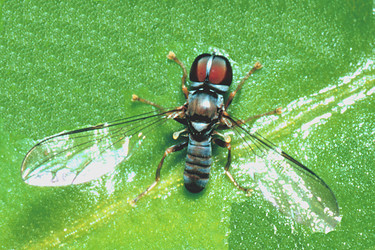Cephalosphaera
Jeff Skevington- Cephalosphaera (Cephalosphaera)
- Cephalosphaera (Neocephalosphaera)
- Cephalosphaera amboinalis (incertae sedis)
- Cephalosphaera baltica
 (incertae sedis)
(incertae sedis) - Cephalosphaera hikosanus (incertae sedis)
- Cephalosphaera honshuensis (incertae sedis)
- Cephalosphaera immodica (incertae sedis)
- Cephalosphaera kasparjani (incertae sedis)
- Cephalosphaera motichoorensis (incertae sedis)
- Cephalosphaera prolata (incertae sedis)
- Cephalosphaera redunca (incertae sedis)
Introduction
The 53 valid species of Cephalosphaera are distributed among two subgenera. Nine species are currently unplaced at the subgeneric level (listed as incertae sedis above).
Characteristics
Cephalosphaera are often large, heavily pollinose flies, readily distinguished at the generic level in the field. The following combination of characters allow lab identification of Cephalosphaera specimens: hind margin of eye straight, ocellar bristles reduced (these characters place them within Pipunculinae); propleuron with a fan of setae (includes Collinias, Microcephalops, Pipunculus, Cephalosphaera and Cephalops), frons not swollen, face not narrowed, discal medial cell expanded medially (excludes Collinias and Microcephalops), setae on thorax restricted to two dorsocentral rows and scattered setae along margins (excludes Pipunculus) and Vein M2 present (excludes Cephalops).
Cephalosphaera is a well-studied genus on a world scale. The best regional keys to use to identify Cephalosphaera species are as follows: Australia – Skevington (1999), Afrotropical – De Meyer (1992), Costa Rica – Rafael and Menezes (1999), Japan – Morakote and Hirashima (1990), Nearctic - De Meyer (1989a), Neotropics – Rafael (1992), New Guinea – De Meyer (1990), and West-Palaearctic - De Meyer (1989b).
Discussion of Phylogenetic Relationships
De Meyer (1994) provides a phylogenetic analysis for the Cephalopsini.
References
De Meyer, M. 1989. Systematics of the Nearctic species of the genus Cephalops Fallén (Diptera, Pipunculidae). Bulletin de l'Institut Royal des Sciences Naturelles de Belgique, Entomologie 59:99-130.
De Meyer, M. 1992. Revision of the Afrotropical species of Cephalops Fallén (Diptera, Pipunculidae). Journal of African Zoology 106:81-111.
De Meyer, M. 1994. Phylogenetic relationships within the Cephalopsini (Diptera, Pipunculidae). Bulletin et Annales de la Société Royale belge d'Entomologie 130:7-18.
De Meyer, M., and P. Grootaert. 1990. Pipunculidae (Diptera) from Papua New Guinea: the genera Cephalosphaera, Cephalops and Beckerias. Zoologica Scripta 19:403-412.
Morakote, R., and Y. Hirashima. 1990. A systematic study of the Japanese Pipunculidae (Diptera) Part III. The genus Cephalops Fallén. Journal of the Faculty of Agriculture, Kyushu University 34:183-214.
Rafael, J. A. 1992. Review of the Neotropical species of Big-headed Flies, genus Cephalosphaera (Diptera: Pipunculidae). Pages 633-646 in Insects of Panama and Mesoamerica. Seclected studies (D. Quintero, and A. Aiello, eds.). Oxford University Press, Oxford, New York, Tokyo.
Rafael, J. A. 1996. Pipunculidae (Insecta, Diptera) of the Dominican Republic: new records and description of new species. Annals of the Carnegie Museum 65:363-381.
Rafael, J. A., and M. D. d. S. Menezes. 1999. Taxonomic review of Costa Rican Pipunculidae (Insecta: Diptera). Revista de biologia tropical 47:513-534.
Skevington, J. H. 1999. Cephalosphaera Enderlein, a genus of Pipunculidae (Diptera) new for Australia, with descriptions of four new species. Australian Journal of Entomology 38:247-256.
Title Illustrations

| Scientific Name | Cephalosphaera |
|---|---|
| Specimen Condition | Live Specimen |
| Identified By | Jeff Skevington |
| Sex | Female |
| Life Cycle Stage | adult |
| Copyright |
© Steve Marshall

|
About This Page

Agriculture and Agri-Food Canada, Ottawa, Ontario, Canada
Correspondence regarding this page should be directed to Jeff Skevington at
Page copyright © 2005
 Page: Tree of Life
Cephalosphaera.
Authored by
Jeff Skevington.
The TEXT of this page is licensed under the
Creative Commons Attribution License - Version 3.0. Note that images and other media
featured on this page are each governed by their own license, and they may or may not be available
for reuse. Click on an image or a media link to access the media data window, which provides the
relevant licensing information. For the general terms and conditions of ToL material reuse and
redistribution, please see the Tree of Life Copyright
Policies.
Page: Tree of Life
Cephalosphaera.
Authored by
Jeff Skevington.
The TEXT of this page is licensed under the
Creative Commons Attribution License - Version 3.0. Note that images and other media
featured on this page are each governed by their own license, and they may or may not be available
for reuse. Click on an image or a media link to access the media data window, which provides the
relevant licensing information. For the general terms and conditions of ToL material reuse and
redistribution, please see the Tree of Life Copyright
Policies.
- First online 02 November 2005
Citing this page:
Skevington, Jeff. 2005. Cephalosphaera. Version 02 November 2005 (under construction). http://tolweb.org/Cephalosphaera/54645/2005.11.02 in The Tree of Life Web Project, http://tolweb.org/








 Go to quick links
Go to quick search
Go to navigation for this section of the ToL site
Go to detailed links for the ToL site
Go to quick links
Go to quick search
Go to navigation for this section of the ToL site
Go to detailed links for the ToL site